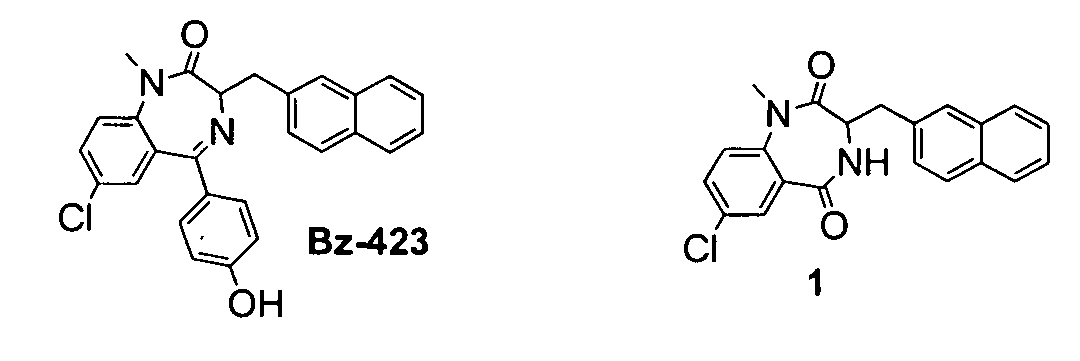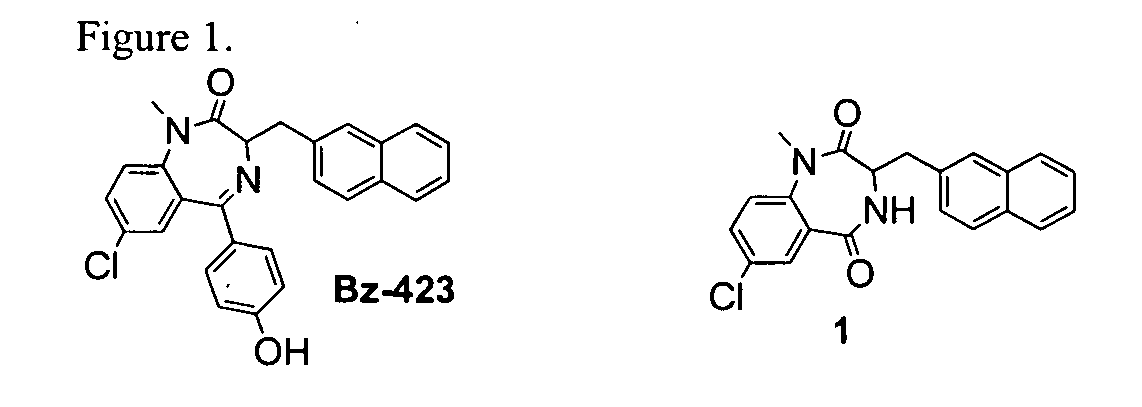Novel 1,4-benzodiazepine-2,5-diones with therapeutic properties
a technology of benzodiazepine and diones, applied in the field of new chemical compounds, can solve the problems of limiting efficacy, serious drawbacks of existing cytotoxic chemotherapeutic agents, and serious deleterious effects in the organism
- Summary
- Abstract
- Description
- Claims
- Application Information
AI Technical Summary
Benefits of technology
Problems solved by technology
Method used
Image
Examples
example 1
[0178] This example describes the formulation of exemplary 1,4-benzodiazepine-2,5-diones. As shown in FIG. 1, Bz-423 is a pro-apoptotic 1,4 benzodiazepine with potent activity in animal models of lupus (see, e.g., Blatt, N. B., et al., J. Clin. Invest. 2002, 10, 1123; Bednarski, J. J., et al., Arthritis Rheum. 2003, 48, 757; each herein incorporated by reference in their entiretiese). Bz-423 binds to the oligomycin sensitivity conferring protein (OSCP) component of the mitochondrial F1F0-ATPase (see, e.g., Johnson, K. M., et al., Chemistry and Biology. 2005, 12, 485; herein incorporated by reference in its entirety). Bz-423 inhibits the enzyme, which produces a state 3 to state 4 transition within the mitochondrial respiratory chain (MRC), ultimately resulting in the production of O2− from MRC complex III. This reactive oxygen species functions as a signal—initiating a tightly-regulated apoptotic process (see, e.g., Johnson, K. M., et al., Chemistry and Biology. 2005, 12, 485; herei...
example 2
[0180] This example describes the optimization of the novel 1,4-benzodiazepine-2,5-dione compounds of the present invention. The data in FIG. 2 show that the size of the C3 is important for the activity of the 1,4-benzodiazepine-2,5-dione compounds. Moreover, these data suggest that it is possible to optimize potency and selectivity based on the biphenyl or 2-napthylene C3 side chains. A range of substituted biphenyls can be prepared readily by Suzuki couplings of aryl halides with commercially available boronic acids (see, e.g., Suzuki, A. Acc. Chem. Res. 1982, 15, 178; herein incorporated by reference in its entirety). Therefore, the relationship between the stereoelectronics of the C3 side chain and cytotoxicity of the 1,4-benzodiazepine-2,5-dione compounds, was further evaluated by synthesizing substituted analogs of 10 (FIG. 3).
[0181] In the first group of derivatives a methyl group or chlorine atom was substituted at each of the 2′, 3′, or 4′-positions. Analysis of these comp...
example 3
[0183] This example demonstrates that 1,4-benzodiazepine-2,5-dione compounds of the present invention do not inhibit ATP synthesis. The following four compounds were exposed to cells, and ATP synthesis measured:
As shown in FIG. 6, the following compounds
failed to inhibit ATP synthesis, while
did inhibit ATP synthesis.
PUM
| Property | Measurement | Unit |
|---|---|---|
| particle size | aaaaa | aaaaa |
| resistance | aaaaa | aaaaa |
| chemo-resistance | aaaaa | aaaaa |
Abstract
Description
Claims
Application Information
 Login to View More
Login to View More - R&D
- Intellectual Property
- Life Sciences
- Materials
- Tech Scout
- Unparalleled Data Quality
- Higher Quality Content
- 60% Fewer Hallucinations
Browse by: Latest US Patents, China's latest patents, Technical Efficacy Thesaurus, Application Domain, Technology Topic, Popular Technical Reports.
© 2025 PatSnap. All rights reserved.Legal|Privacy policy|Modern Slavery Act Transparency Statement|Sitemap|About US| Contact US: help@patsnap.com



